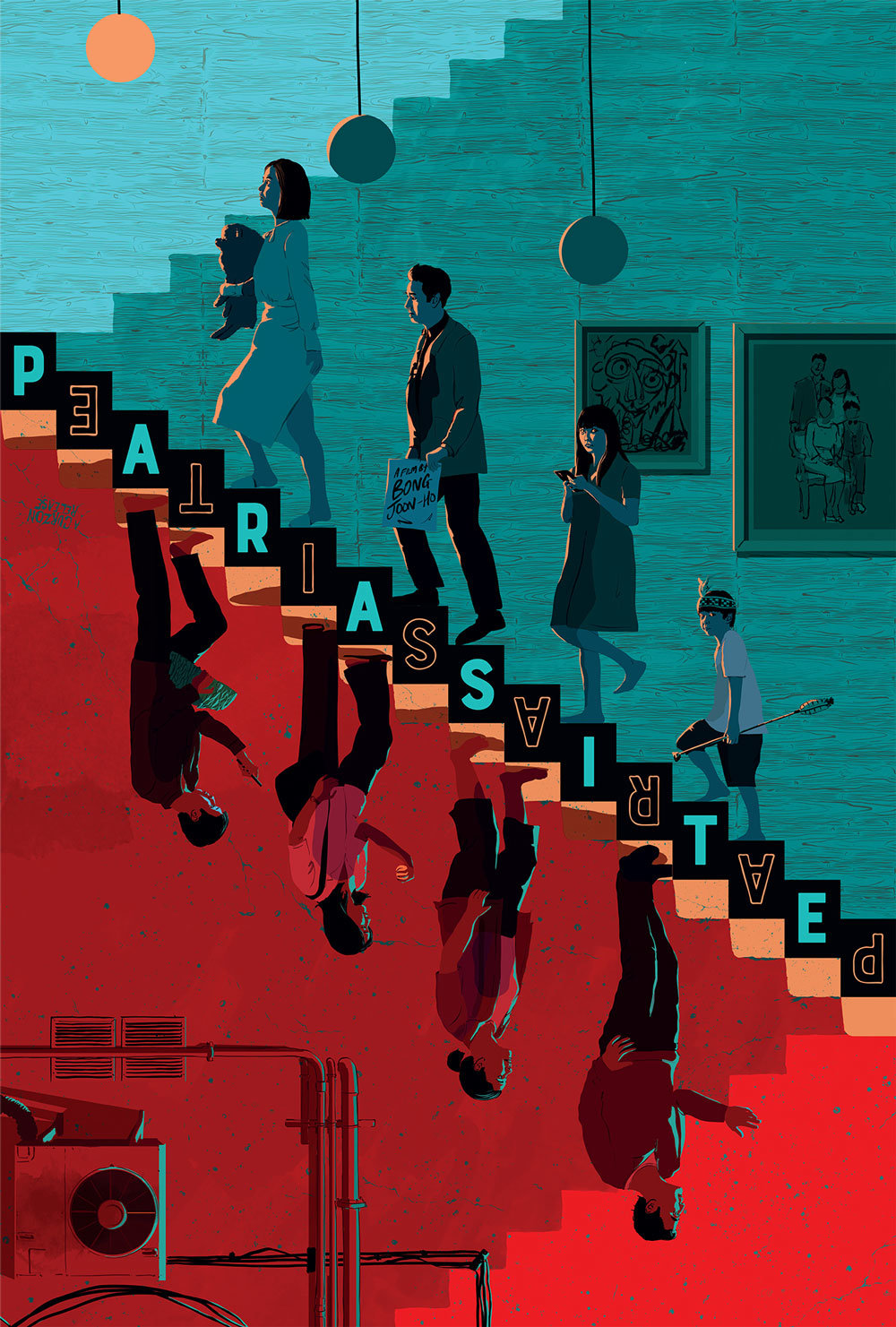February 12, 2020 | Clara Keane, AATA National Office Staff
Parasite made history during the 2020 Oscars, winning four awards and becoming the first non-English-language film to win best picture, the Academy’s highest honor. This acclaimed playful yet dark satire thriller highlights the opposite spectrums of social class in urban South Korea, taking a microscope to two families whose paths become intertwined when Kim Ki-woo begins tutoring English to the daughter of the wealthy Park family. The clever Kim family devises elaborate schemes to secure employment for each family member without the Parks learning that they are related. The Kims expertly build narratives and forge documents to support claims of their unique qualifications and even carry out plots to have the current house keeper and driver fired as they con their way into various roles within the household.

Alternative UK poster for “Parasite.” Art by Andrew Bannister.
Looking for opportunities to increase her going rate as an art tutor for the Parks’ young son Da-song, who is passionate about painting and struggles with behavioral challenges, the Kim sister Ki-jeong googles “art therapy” and skillfully fabricates a new identity, inventing symbols and meaning in artwork to her advantage. Viewers recognize that Ki-jeong is clearly capitalizing on the gullible nature of Yeon-gyo, mother of the Park family, to charge top rate for her services.
Parasite’s success puts art therapy in an international light and offers an opportunity to delve into what exactly art therapy is. Had Ki-jeong done a little more research, she would have also forged her master’s degree as part of the ruse.
People intuitively understand the mental health benefits of art making but may not be familiar with art therapy as a profession
Even as recent advancements in understanding the brain have increased public awareness of how the art-making process can lead to improved physical and mental health, general consumers are often unfamiliar with the field of art therapy or may have misconceptions about it – often thinking it’s either simply arts and crafts or a psychic analysis of one’s artwork. Ki-jeong was easily able to manipulate this lack of understanding to her own benefit, making up a fake yet compelling story to draw in the young boy’s mother Yeon-gyo.
In the United States, art therapy is defined as a mental health profession that uses active art-making, creative process, applied psychological theory, and human experience within a psychotherapeutic relationship. Art therapists have master’s degrees and extensive clinical training, and understand how art interacts with a client’s psychological disposition. They are able to safely manage and interpret the reactions different art processes may evoke.
Art therapy is also established in South Korea, and the Korean Art Therapy Association, for example, has been around for 30 years. “The movie reflected the current stage of art therapy in South Korea so well,” says Moon Jeehee, who holds a master’s degree in art therapy from the Graduate School of Professional Therapeutic Technology, Seoul Women’s University in South Korea, and is currently pursuing her second master’s in art therapy at Notre Dame de Namur University in California. “There are so many people who are not trained properly but still take on clients as art therapists, just like Ki-woo’s sister.” Jeehee views the film as a bridge to talk about what is wrong and what is right in how art therapy was portrayed. “If I were in Korea, and if I told people that I’m an art therapist, they will probably start to talk about what they saw in Parasite, and it’s my time to correct the false information” she explains.
Art therapists look to symbols in clients’ artwork to make assessments
After the first lesson with Da-song, the so-called art therapist Ki-jeong speaks with his mother Yeon-gyo alone. Ki-jeong seemingly arbitrarily asks if Da-song had experienced any trauma in first grade, to which Yeon-gyo gasps in acknowledgement. “The lower right region of the painting is called the schizophrenia zone,” Ki-jeong says pointing to the corner of Da-song’s artwork. “Psychotic symptoms often reveal themselves here,” she continues. Fully believing the bold claim, Yeon-gyo finds a similar shape in the corner of another of her son’s painting hanging on the wall. Ki-jeong closes the deal with an irresistible invitation: “This is all a black box into Da-Song’s mind. Would you like to open the box with me, Madame?”
While art therapy has been shown to be an effective treatment for people with psychosis, Ki-jeong’s assertion that there could be a region on a page that indicates schizophrenia is clearly contrived. Art therapists certainly do make assessments using the art product and art making process to help determine the client’s level of functioning, set treatment objectives and evaluate progress, and to better understand the client’s struggles and strengths. However, a drawing is by no means a concrete roadmap to a person’s inner thoughts.
The client is always the expert on their own artwork, and the art therapist is there to guide them through their personal growth. Art therapists are mindful that there is no standard image or depiction that can reliably indicate trauma or pathology. Through the art making process and dialogue that may ensue, the art therapist builds trust and rapport within the psychotherapeutic relationship that is necessary for healing.
Art therapy helps people cope after traumatic events
It’s not until much later in the film that we learn the details about Da-song’s traumatic experience. Yeon-gyo confides in another Kim family member in her employ that Da-song had a seizure in the middle of the night on his sixth birthday after seeing a ghost in the kitchen. “His eyes rolled back in his head, convulsions, foam in his mouth,” Yeon-gyo describes.
Art therapy is especially effective for children and adults who have experienced trauma, as it offers an alternative to verbal expression alone. It recognizes the power of art and art-making to stimulate memories and reveal emotions. For trauma survivors, the creative process can be a safe way to explore and communicate traumatic memories with an art therapist. The drawing, mask, or other art product can then offer an external depiction of the person’s internal experience.
We applaud Parasite for breaking a historic cultural barrier, becoming the first non-English language film to win the best picture Oscar. While we may critique the film in failing to fully flesh out art therapy as a regulated mental health profession, there is still value in watching it and having conversations with friends, families, and other moviegoers about art therapy and its benefits, particularly with those who have experienced trauma.
AATA President Margaret Carlock Russo, EdD, LCAT, ATR-BC, ATCS has a note for viewers: “I know that many people will be inspired to go out and watch this movie that has won so many accolades. I hope that they will also be inspired to learn more about art therapy. Whether viewers have a child dealing with the ramifications of trauma or they themselves are struggling with life’s challenges, I encourage them to reach out to an art therapist. Others may even be steered toward an exciting career as an art therapist.”
Clara Keane, Manager, Advocacy & Public Affairs
Clara supports our chapter state legislative and regulatory efforts and acts as liaison between the AATA and our partners in the wider mental health and arts communities. Clara also manages our bi-weekly newsletter Art Therapy Today.

